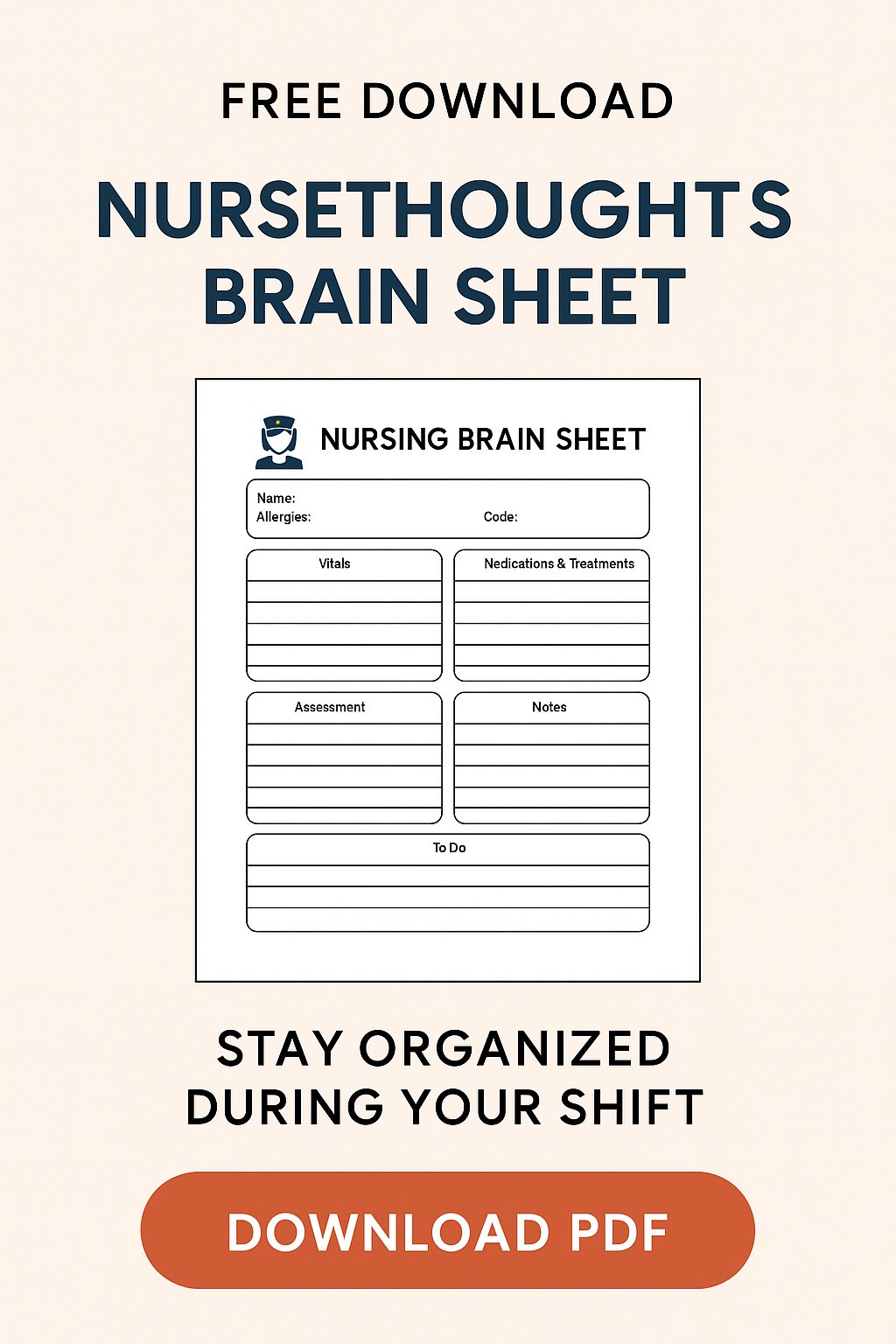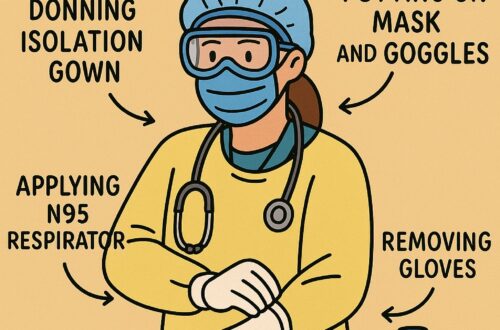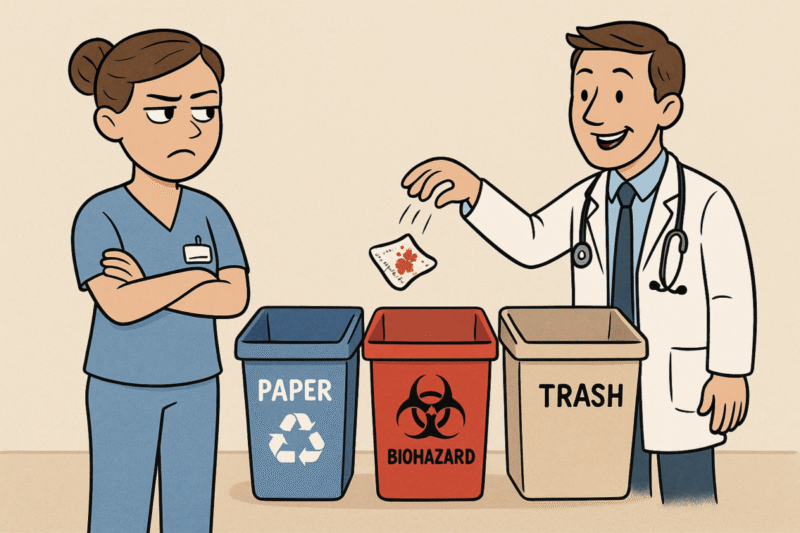It’s 6:59 a.m. The unit smells like a mix of burnt coffee and fear. You’ve got three pens, two granola bars, and a vague idea that someone’s potassium is dangerously low in room 212. The charge nurse is already glaring.
You flip open your clipboard, and there it is — your nurse brain sheet. That magical piece of paper that keeps your shift (and your sanity) from spiraling into chaos. Without it, you’d be wandering the halls like a lost traveler asking, “Wait… who’s NPO after midnight?”
Brain sheets aren’t just a tool. They’re a nurse’s emotional support animal in 8.5 x 11 form. And if you’ve ever tried to survive a 12-hour shift without one, you know it’s like showing up to the Hunger Games with nothing but a stethoscope.
So let’s talk brain sheets: what they are, why you need one, how to avoid common fails, and how to pimp yours out so it actually helps you survive another round of charting, codes, and call lights.
What Exactly Is a Nurse Brain Sheet?
Think of a brain sheet as your battle plan for the day. It’s the place where you:
- Write patient names, room numbers, allergies, meds, and labs.
- Scribble reminders (“Patient in 314 wants Jell-O at exactly 10:03”).
- Track vitals, assessments, and which IV pump is currently trying to gaslight you.
It’s part cheat sheet, part life raft, and part personal diary of your slow descent into shift madness.
Some nurses go digital (iPads, apps, or fancy EMR features). Others are die-hard paper people with clipboards full of crumpled pages that look like they’ve been through a war zone. Either way — if you’re a nurse, you’ve got some version of this tool.
Why Every Nurse Needs One (Even If You Pretend You Don’t)
There are two types of nurses:
- The Organized Ones who whip out perfectly highlighted, color-coded sheets that look like Pinterest boards.
- The Chaos Gremlins who claim they “just keep it all in their head” … until they forget Mrs. Rodriguez is allergic to bananas and nearly cause a smoothie-related incident.
Why brain sheets are essential:
- Memory Saver: Because no one can keep seven patients’ labs, meds, and family drama straight.
- Legal Lifeline: Documentation is everything. Brain sheets can save you when your brain is fried.
- Shift Survival: They’re the only way you’ll remember that room 410’s family called at 8:00 a.m. and again at 8:02 and again at 8:04.
The Anatomy of a Perfect Nurse Brain Sheet
A truly great brain sheet has:
- Patient Info: Name, age, room, code status.
- Allergies: Highlighted, starred, circled, underlined, tattooed — whatever it takes.
- Vitals & Labs: Track the trends before the doctor rounds.
- Meds & Treatments: Scheduled, PRN, “will definitely be overdue because pharmacy is late again.”
- Notes Section: For odd requests like “patient only drinks water with exactly two ice cubes.”
- Discharge/To-Do List: So you know who’s leaving and who’s adding an extra 3 hours to your day.
Pro tip: Always leave space for doodles, random thoughts, and tiny rage scribbles about your IV pump.
Funny Nurse Brain Sheet Fails
Let’s be real — your brain sheet doesn’t always save you. Sometimes it betrays you.
- The Coffee Spill at 9:01 a.m. Congratulations, your neatly organized shift is now a sepia-toned watercolor painting.
- Illegible Handwriting: You can’t tell if you wrote “Tylenol” or “Tracheostomy.” Either way, it’s a problem.
- The Disappearing Sheet: Somewhere between Room 305 and the Pyxis, your sheet vanished into another dimension. (Bonus points if you find it in your scrub pocket two days later.)
- The “Too Organized” Trap: You spent so long making it look pretty that you forgot to actually pass meds.
Digital vs. Paper: The Great Debate
Paper Loyalists:
- “I like the feel of pen and paper.”
- “Tech always crashes.”
- “I can fold it, shove it in my pocket, and use it to fan myself during codes.”
Digital Converts:
- “No smudges, no spills, no pen theft.”
- “Cloud storage means I never lose it.”
- “I can copy-paste patient data instead of writing ‘Smith, J.’ twenty times.”
Truth: Most nurses use both. Because while your iPad might be great, sometimes nothing beats the speed of scribbling “Mr. Jones hates needles” in the margin at 3 a.m.
Free Templates & How to Make Your Own
The internet is FULL of free brain sheet templates, but not all are created equal. Some look like NASA launch checklists, others like kindergarten homework.
What to look for:
- Enough space for notes
- Sections for meds, labs, vitals, and tasks
- Easy to print (black-and-white friendly)
💡 Pro-Tip: Customize one! Start with a template, then tweak it until it feels like YOUR workflow.
Top Nurse Brain Sheet Survival Hacks
- Color Coding: Red for allergies, green for discharges, blue for meds.
- Pre-Fill Before Shift: Fill in patient names/rooms during report — saves time later.
- Double Copies: Keep one on clipboard, one hidden in pocket (because chaos).
- Abbreviations Are Life: “NPO,” “D/C,” “PRN.” Just don’t invent your own.
- Laminate Trick: Some nurses laminate one sheet and use dry-erase markers. Reusable + spill-proof.
- The “Back of the Sheet” Hack: Perfect place for phone numbers, random orders, or angry doodles.
How Brain Sheets Keep You Sane on a 12-Hour Shift
- They give you tiny wins: checking off a box feels like beating a level in a video game.
- They help you predict chaos: you’ll know which patient will need you every 12 minutes.
- They remind you you’re not just a shift zombie — you’re a shift zombie with a plan.
Closing: Your Emotional Support Brain Sheet
At the end of the day (or night), your nurse brain sheet is more than just paper or pixels. It’s your anchor in the storm. It’s the difference between surviving your shift and completely losing track of who’s getting their potassium recheck. Use it to help you improve patient safety, as emphasized by Joint Commission.
So embrace your sheet. Tweak it. Spill coffee on it. Curse it when it betrays you. And remember — behind every great nurse is an even greater brain sheet.
Because while you can’t control the call lights, the chaos, or the never-ending charting… you CAN control the piece of paper keeping you sane.





